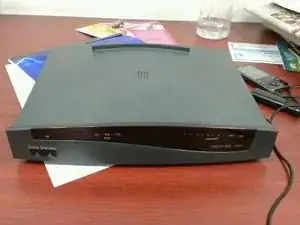Einleitung
If one wants to replace the flash memory in a cisco 871 router with a new one with bigger capacity, some issues will appear, like losing the IOS image or losing some files residing on the flash memory. In order to avoid this, the files residing on flash must be backed-up on a tftp server.
Below is how I changed the flash memory in a cisco 871 router with a bigger one.
Before to start the procedure, back up all the needed files to a tftp location, including the IOS image. All the operations will require a serial console connection to the router (no telnet). I used a Linux machine to connect with the router by serial console using minicom (recommended, from the command line) or putty to communicate with the device.
To replace the flash memory is easy, just open the router and swap the memory found in the left socket (see picture).
Then the tricky part begins.
The router it won’t start, even if the old flash it is inserted back. It will complain about the flash file system, like:
System Bootstrap, Version 12.3(8r)YI4, RELEASE SOFTWARE
Technical Support: http://www.cisco.com/techsupport
Copyright (c) 2006 by cisco Systems, Inc.
C870 series (Board ID: 3-148) platform with 131072 Kbytes of main memory
flashfs[0]: inconsistent sector list, fileid 2, parent_fileid 0
flashfs[0]: inconsistent sector list, fileid 3, parent_fileid 0
No bootable image file: flash:/
Unable to open boot file
The solution is to enter to ROMMON using BREAK sequence from the communication software (minicom or putty) then to load the IOS image from the tftp server where was previous saved, using the first Fast Ethernet interface Fa0 as network connection; the WAN connection (Fa4) will not work. At the ROMMON prompt use (warning: the commands are CASE SENSITIVE):
rommon 1 >dir flash:
to see the flash filesystem (it may take a while until the router will accommodate with the new flash size). Delete the old image that now have 0 bytes in size. Use the following commands (replacing the actual IP addresses with the ones used in your particular setup)
rommon 2 > IP_ADDRESS=192.168.2.10
rommon 3 > IP_SUBNET_MASK=255.255.255.0
rommon 4 > DEFAULT_GATEWAY=192.168.2.101
rommon 5 > TFTP_SERVER=192.168.2.101
rommon 6 > TFTP_FILE=cisco/c871/c870-advipservicesk9-mz.124-24.T7.bin
rommon 7 > tftpdnld
IP_ADDRESS: 192.168.2.10
IP_SUBNET_MASK: 255.255.255.0
DEFAULT_GATEWAY: 192.168.2.101
TFTP_SERVER: 192.168.2.101
TFTP_FILE: cisco/c871/c870-advipservicesk9-mz.124-24.T
Werkzeuge
Ersatzteile
CONCLUSION
Replacing flash need a tftp server available;
Replacing flash need a copy of the IOS image;
Replacing flash need the usage of ROMMON; be sure that this is possible;
Removing the flash card and inserting it back is like replacing with a new one (IOS image will be gone, so don’t play it with ease);
use the first ethernet port to connect with the tftp server, although all 4 switch ports will work presumably because all being in the same first VLAN.
To reassemble your device, follow these instructions in reverse order and that's all.

